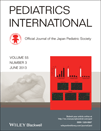Risk factors for symptoms in long QT syndrome patients in a single pediatric center
Abstract
Background
Long QT syndrome (LQTS) is a leading cause of sudden cardiac death due to arrhythmia in the pediatric population. This study aimed to determine risk factors for the presence of LQTS-related symptoms in a single pediatric center.
Methods
Subjects were 146 consecutive LQTS patients (M:F = 72:74) who visited our hospital between April 2005 and August 2012 and during the preceding 24 months. A total of 103 subjects were discovered by the school-based screening, 15 subjects visited because of their symptoms, and the others were 28 subjects. One subject died.
Results
Risk factors for the presence of symptoms after diagnosis were longer QTc values (P = 0.01), the presence of history of LQTS-related symptoms (P = 0.04), and longer follow-up periods (P = 0.03). Non-compliance with medicine was the sole risk factor for frequent symptoms after diagnosis (P = 0.02). In subjects discovered by the school-based screening, nine subjects (9%) had LQTS-related symptoms after diagnosis. Longer follow-up periods were the sole risk for the presence of symptoms (P = 0.04). The mean period until the presence of symptoms after diagnosis was 3.1 ± 2.7 years (0.1–7.1 years).
Conclusion
Good compliance with medicine is essential to prevent recurrent episodes. A new strategy is required to prevent subjects, including school-based screened subjects, from dropping out of hospital visits.




